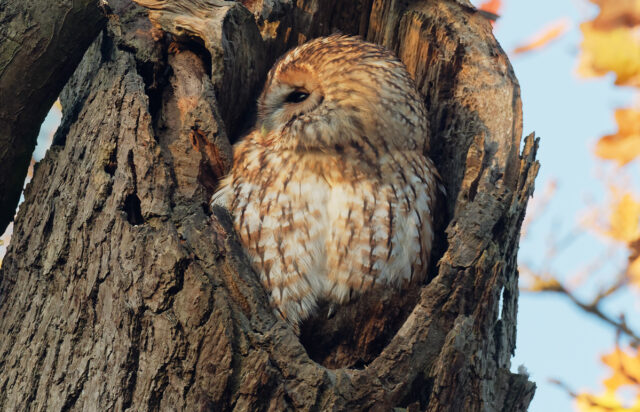Despite being reasonably common, widespread, and easily identifiable from its vocal behaviour, we know surprisingly little about the changing fortunes of the UK’s breeding Tawny Owl population. There is evidence for an ongoing but shallow long-term decline in the population since the mid-1980s, but this evidence comes from studies that involve daytime surveys by volunteers. Better information is likely to come from dedicated surveys, carried out at night during the Tawny Owl’s breeding season, when territorial vocal activity is at its peak.
Such dedicated surveys typically rely on the use of call playback to elicit responses from territorial birds, a labour-intensive method that limits survey coverage. An alternative approach has been tested using nearly 10,000 volunteer ‘citizen scientists’ and the results are extremely encouraging. The BTO Tawny Owl Calling Survey set out to establish the factors that influenced Tawny Owl calling behaviour (such as weather conditions and local habitat) and to determine whether the approach could reveal changes in Tawny Owl populations over time.
The BTO Tawny Owl Calling Survey was carried out over two separate survey periods (October to March in 2005/06 and 2018/19) and had a particular focus on the impact of urbanisation. Volunteers carried out surveys across each winter period, avoiding evenings that were wet, windy or had poor visibility. They were asked to record whether they heard Tawny Owls calling during the survey period, and to specify the types of Tawny Owl calls heard. The volunteers also collected data on the amount of cloud cover, which was used alongside environmental data from other sources to identify factors that might influence calling behaviour.
Some 9,452 volunteers took part in the survey in 2018/19 and 3,465 took part in 2005/06, collectively covering 9,567 sites. Overall, Tawny Owls were reported at least once from 86.8% of sites in 2005/06 and 84.3% of sites in 2018/19, suggesting that Tawny Owl populations have been largely stable over this period.
Dr Hugh Hanmer, lead researcher on the project, commented “The data generated by our volunteers inform our understanding of Tawny Owl calling behaviour and of the types of sites where they occur. Importantly, these data can be used to shape the design of future surveys. For example, the results of the volunteers’ weekly efforts imply that five or six survey visits would be needed within a survey season to determine with confidence whether Tawny Owls are present at a site or not.”
Surveys carried out in the autumn and early winter were more likely to detect an owl at occupied sites than those carried out in the middle of winter, but there was an upturn in activity in early spring. Such patterns almost certainly reflect the changing territorial behaviour over this period, with Tawny Owls likely to be more vocal in the autumn as established adults respond to the settlement of dispersing juveniles, and increase their vocal activity again in spring when breeding begins in earnest. Tawny Owls were less vocal on cloudy nights and when it was raining, but more active on nights when the moon was fuller.
The two strongest factors influencing whether or not Tawny Owls were present at a site were the amount of broadleaf woodland cover locally and the amount of artificial light at night, the latter a measure of the degree of urbanisation. Occupancy increased with woodland cover, but declined as the degree of urbanisation (and artificial light at night) increased.
Michelle Reeve, BTO Garden BirdWatch Manager (and whose volunteers played an important role in the study) commented “The study demonstrates the tremendous value in being able to use citizen scientists to capture data on Tawny Owls and engage both new and existing volunteers with active participation in science. This is a bird that many of us will know; even if we have never seen one its hooting call is likely to be familiar.”




